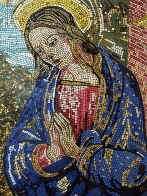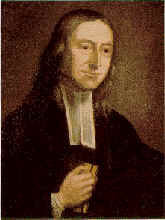 earth.
earth.APPRECIATING THE SAINTS
We were motoring past a rather splendid garden centre when I spotted what I thought was the very thing I’d been looking for: a statue of St Francis. It was going to be a surprise for my wife. I was intending to install my favourite saint on the lawn so that he would be framed by the garden arch.
As we turned into the garden centre I was forced to share my ambitious plan with my wife. She immediately expressed the view that it was an unjustified extravagance though she did appreciate the kind thought. "Well," I said, "at least we can go over and take a look." We moved cautiously among the serried ranks of gnomes, frogs, angels and comely maidens till at last we reached the saint.
I must say that the carving was excellent, right down to the folds in St Francis’ habit and the tiny bird on his out-stretched hand. Oh, but the face! It was awful – morose and threatening as a thunder cloud. We agreed that it was an insult to Assisi’s famous son and that putting it in the garden would scare the birds.
This reference to one particular saint leads me, on this All Saints Day, to reflect on saints in general. St Paul in his letters to the various churches uses the word to describe all Christian believers, when the Nicene Creed (AD 325) refers to the communion of saints it means all of us Christians. But if today our minister began his monthly letter with the words "Dear Saints", we should think that he was pulling our legs or at least had his tongue in his cheek.
The label ‘saint’ came over time to be
reserved for particular people who had demonstrated in their lives a more than
usual awareness of God and an outstanding degree of holiness. In the days when
Christians died for their faith they were often venerated as saints. There was a
widespread belief that because of their nearness to God they could effectively
intercede in heaven for those still on earth.
earth.
In the 10th century Pope John XV introduced the procedure of canonisation whereby individuals were officially recognised as saints. It is a lengthy process which examines the candidate’s credentials and insists among other things that he or she must have performed at least two miracles.
Many churches, associations and places have patron saints. So, for example, St Patrick in the patron saint of Ireland because he is credited with having introduced Christianity to the Irish people. Whether Patrick is entirely pleased with this arrangement is another matter for he may well shed tears when he observes how the religion he introduced has helped create so much strife.
It is an interesting fact that all the great religions have their saints. In some cultures local or national gods are treated as patron saints. I discovered that in China K’uei Hsing is the patron saint of scholars. He apparently passed his civil service examinations with great distinction and is able, so many believe, to enable others to achieve similar success. (A useful character to have around!)
The astute reader of the Methodist Recorder (and
are there any other kinds of reader?) will probably be saying that not many
column inches a year are devoted to the subject of saints. It is true that we
Methodists don’t go in very much for statues, saints’ days and all that sort
of thing, tho ugh
Wesley’s Chapel has a few busts of famous Methodists, a statue of our founder
and a splendid recently unveiled window commemorating my dear friends Donald and
Bertha English. I think it is a pity that we have largely cut ourselves off from
a stream of Catholic piety which has enriched so many of our fellow Christians.
The Virgin Mary – the greatest saint of all – finds small place in our
devotions, except at Christmas when with the rest we are happy to sing songs
about that ‘most highly- favoured lady’.
ugh
Wesley’s Chapel has a few busts of famous Methodists, a statue of our founder
and a splendid recently unveiled window commemorating my dear friends Donald and
Bertha English. I think it is a pity that we have largely cut ourselves off from
a stream of Catholic piety which has enriched so many of our fellow Christians.
The Virgin Mary – the greatest saint of all – finds small place in our
devotions, except at Christmas when with the rest we are happy to sing songs
about that ‘most highly- favoured lady’.
There are of course those among us who are aware of the value of those traditions which emphasise sainthood. At college, dear George Lockett – himself a very real saint – observed all the saints’ days in his daily devotions. The late Neville Ward explored the value of the rosary. I have never ceased to be grateful for John Newton’s book ‘Search for a Saint’. (Will the saint who borrowed my copy please return it!)
As we grow closer to our Roman Catholic friends we discover that among the important things we have in common there is the emphasis on holiness which was at the heart of John Wesley’s preaching. That is what matters. A church that produces no saints is a church that has failed.
We do not need to adopt all the paraphernalia of canonisation and, certainly, the flesh and blood reality of holy people is more important than holy images, saints alive more valuable than sacred statues. But we can learn to appreciate the colour and richness of those traditions which have employed these means of expressing the truth that men and women can get so close to God that we immediately recognise them as saints. Such appreciation could do us nothing but good.
Written by Rev Kenneth Greet
the Methodist Recorder
November 2001